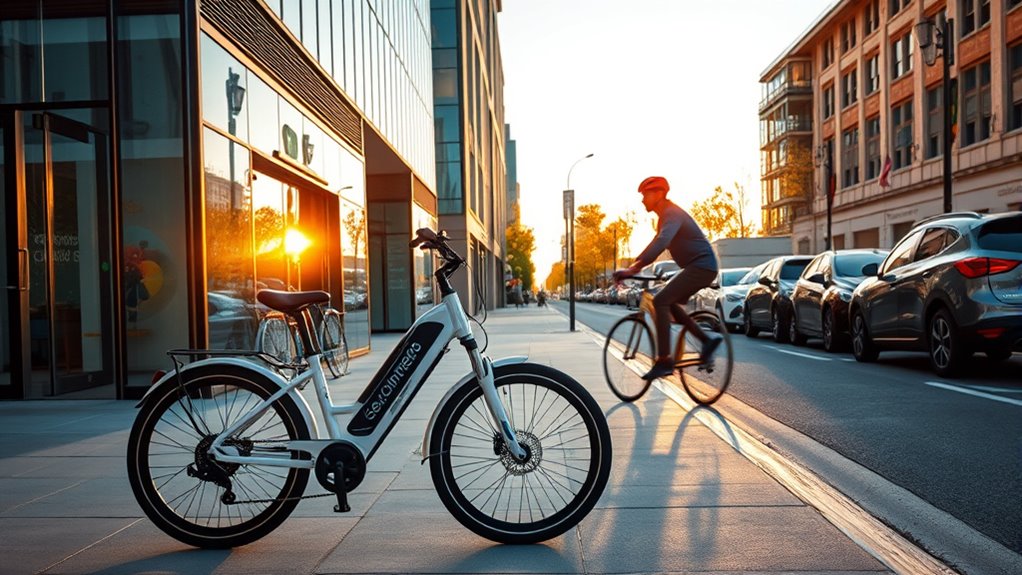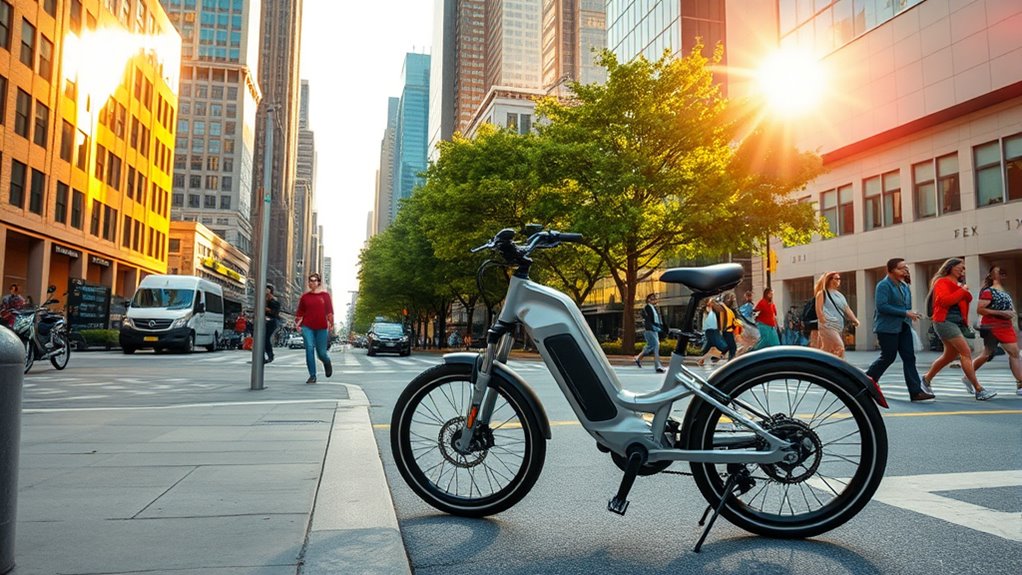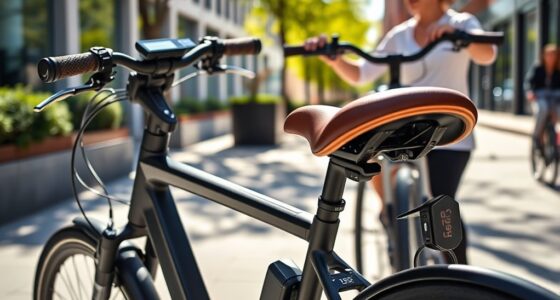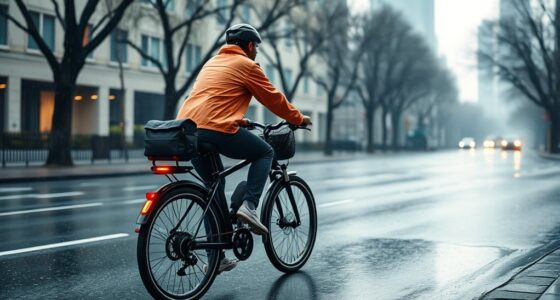Ditching your car for an e-bike can save you money on fuel, parking, maintenance, and tolls, making your commute much cheaper. It also benefits the environment with zero emissions and improves your health through increased physical activity. Plus, e-bikes offer convenience and flexibility, helping you avoid urban traffic and parking hassles. If you want to understand how these savings add up and why this switch makes sense, there’s more to discover below.
Key Takeaways
- E-bikes significantly reduce transportation costs by eliminating fuel, parking fees, and maintenance expenses.
- Long-term savings from e-bike commuting outweigh initial purchase costs.
- Charging e-bikes during off-peak hours minimizes energy expenses.
- E-bikes decrease reliance on costly car-related expenses like tolls and repairs.
- Switching to e-bikes promotes sustainable, cost-effective transportation, lowering overall commuting costs.

Switching from a car to an e-bike for your daily commute can considerably save you money. Not only do you cut down on fuel costs and parking fees, but you also reduce wear and tear on your vehicle, which lowers maintenance expenses. But beyond the financial savings, making the switch offers significant environmental and health advantages. E-bikes produce zero emissions, meaning your daily ride doesn’t contribute to air pollution or greenhouse gases. Over time, this shift can help lessen your carbon footprint, making a tangible difference in combating climate change. If you’re environmentally conscious, the impact of choosing an e-bike over a car adds up, especially considering the millions of miles driven annually by cars that release harmful pollutants into the atmosphere.
In addition to the environmental benefits, riding an e-bike can vastly improve your health. Unlike a car, an e-bike encourages physical activity, which can boost cardiovascular health, strengthen muscles, and enhance overall fitness. The pedal-assist feature makes riding accessible even for those who might find traditional cycling strenuous, allowing you to gradually increase your activity level without feeling overwhelmed. Regular e-bike commutes can lead to better mental health, reducing stress and increasing feelings of well-being. You get the added bonus of fresh air and sunlight, which can lift your mood and improve your energy levels throughout the day. Additionally, choosing an e-bike can help you optimize your projector setup by providing a cost-effective way to get around for outdoor movie nights or tech events.
Economically, switching to an e-bike reduces your reliance on costly car-related expenses. Gasoline prices fluctuate, but your e-bike’s electricity costs are relatively stable and minimal. Charging your e-bike is far cheaper than filling a tank, and in many cases, you can charge it using solar power or during off-peak hours to save even more. Plus, with fewer trips to the gas station or car maintenance shop, you save time and money, making your daily commute more efficient. The initial investment in an e-bike might seem higher than a standard bike, but the long-term savings more than compensate for it. You’ll also avoid expenses related to parking fees and tolls, especially if you commute in urban areas where these costs are high.
Frequently Asked Questions
How Do E-Bikes Compare to Public Transit Costs?
When comparing e-bikes to public transit costs, you’ll find e-bikes are more economical overall. Public transit fares add up quickly, especially with daily commutes, while e-bikes have minimal vehicle maintenance costs. Plus, with an e-bike, you save on ongoing expenses like fuel or parking fees. Over time, investing in an e-bike can be markedly cheaper, giving you more control and flexibility without the recurring costs of public transit.
Are E-Bikes Suitable for All Weather Conditions?
E-bikes are generally weather resistant, but their suitability depends on your local conditions. You’ll want tires with good durability to handle rain, snow, or muddy paths. While many models offer some protection against the elements, extreme weather might require additional gear like fenders, waterproof clothing, or even avoiding riding altogether. Proper maintenance and choosing a weather-resistant e-bike can help you stay safe and comfortable year-round.
What Safety Gear Is Recommended for E-Bike Commuting?
When you’re e-bike commuting, wearing the right safety gear is essential. Always use protective gear like a helmet, gloves, and reflective clothing to safeguard yourself. Visibility accessories, such as bright lights and reflective strips, help you stay seen, especially in low-light conditions. Consider adding a bell or horn for alerting others. Prioritizing safety gear guarantees a safer ride, giving you confidence wherever you travel.
How Long Do E-Bike Batteries Typically Last?
E-bike batteries typically last between 3 to 5 years, depending on your usage and care. You can expect a battery lifespan of around 500 to 1,000 charge cycles. To maximize lifespan, you should avoid frequent deep discharges and keep an eye on charging frequency, ideally charging before the battery is fully drained. Proper maintenance helps make sure your e-bike remains reliable for daily commuting.
Can E-Bikes Handle Steep or Hilly Terrains Effectively?
Imagine your e-bike as a mountain climber, enthusiastic to conquer challenging terrains. Yes, e-bikes handle steep or hilly terrains effectively, thanks to powerful motors and terrain versatility. They provide steady assistance on inclines, making mountain climbing feel less intimidating. Whether you’re tackling rugged hills or steep streets, your e-bike’s endurance and design guarantee you stay confident, embracing every ascent with resilience and ease, just like a climber reaching new heights.
Conclusion
Switching to an e-bike from your car isn’t just about saving money—it’s about embracing a smarter, more liberated way to get around. Imagine gliding effortlessly through traffic, leaving costly fuel and maintenance behind. While your car stays parked, you’ll find yourself enjoying a healthier, more vibrant lifestyle. Sometimes, the best journeys start with a gentle shift—consider this your nudge toward a brighter, more affordable future on two wheels.









